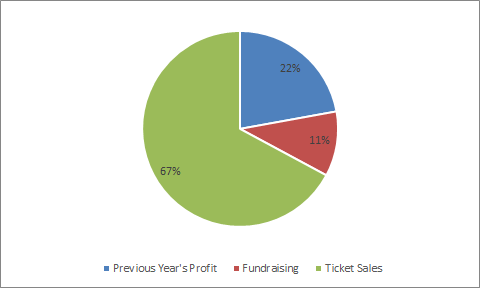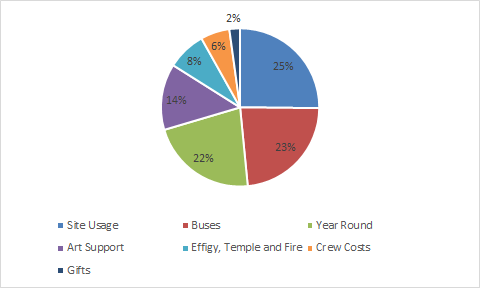This year’s AfterBurn report has finally been released. Check it out here!
One question we are always asked is ‘where does the money go?’. Ironically, even though Dragon Burn (and Burning Man) is an experiment in non-commercialism, getting the thing set up takes quite a lot of time and money. This article is an attempt to explain the way we handle money at Dragon Burn.
Transparency
As a non-profit and an official Regional Burn we are required to be completely transparent about our finances. We work hard to keep track of where the money is spent and our Financial Reports are publicly available on this site. The financial reports for 2014 and 2015 can be found in their respective Afterburn reports, but as of 2016 we are publishing yearly financial reports.
When you run your own fundraisers for art at Dragon Burn we ask that you are equally as transparent about what the money is going towards.
Where Does the Money Come From?

Most of the money last year came from ticket sales. The profit from last year helped us pay many up-front and year-on-year costs, accounting for 22% of our funds this year.
Thanks to many of the theme camps doing their own fundraising this year, we didn’t need to put as much effort into fundraising ourselves. So Dragon Burn’s fundraisers accounted for less than 11% of its income.
As expected we are still relying heavily on ticket sales to cover our costs. The profit from last year helped our cash flow, however ticket sales are still providing most of the money to cover our costs.
Where Does the Money Go?

This year many participants made their own way to the Burn this year, so we spent a little less on buses, meaning for the first time transport wasn’t our largest expense.
Year-round costs include the cost of storing Dragon-Burn owned equipment (site infrastructure, abandoned art projects, safety supplies), site visits and website maintenance.
Site usage includes the site rental, insurance, police permit, general infrastructure and so on. Crew costs cover the security and a medical team, which for safety reasons we decided to hire professionals rather than rely on volunteers. Most of these major costs are covered by the tickets.
Fundraising money generally goes towards art grants, the art truck, and the effigy and temple. Gifts here are things like pendants, flyers, wristbands – things we like to gift to participants at events and the Burn to make things more memorable.
Non-profit is not Zero-profit
If you actually looked at our financial report you will see that Dragon Burn actually made a profit last year. This may surprise a lot of you, but it’s important to remember a few things:
First, no one makes any personal money from Dragon Burn. Many non-profits (including Burning Man) do end up paying people salaries out of necessity, but Dragon Burn is still completely volunteer-run to date.
Second, this report only counts up to December 2016 so does not include any costs from the beginning of this year. This year Dragon Burn has had to renew its storage, pay for site visits, and create more gifts to give away. So far our fundraising hasn’t raised enough to cover those costs.
Finally, it gives the organisation more freedom. This year’s Burn will be 4 days and will happen over a bank holiday. We are confident we can do this because we can pay a lot of our costs up-front. This means a much smoother experience for the volunteer organisers and a better Burn for all participants.
When we consider the cost of a ticket we take this into account. We don’t want to break even (i.e. make zero-profit). We need to make enough money that will also cover Dragon Burn’s costs over the next year and allow the Dragon to continue Burning.
AfterBurn Report
If you want more information on last year’s Burn then check out the AfterBurn report. It details (among other things) a lot of the work that went into Dragon Burn, the art that was brought to Dragon Burn, and the contributions made by various theme camps. It also serves as a retrospective of last year’s Dragon Burn community.

